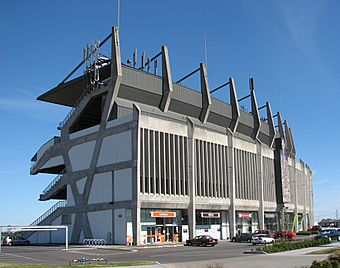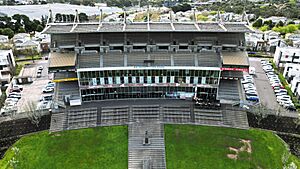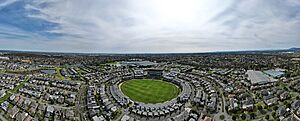Waverley Park facts for kids

Exterior of the Sir Kenneth Luke Stand in 2006
|
|
| Former names | VFL Park |
|---|---|
| Address | 2A Stadium Circuit Mulgrave, Victoria Australia |
| Coordinates | 37°55′32″S 145°11′19″E / 37.92556°S 145.18861°E |
| Owner | Australian Football League |
| Capacity | 2,000 (formerly 72,000) |
| Record attendance | 92,935 – Hawthorn vs Collingwood, 6 June 1981 |
| Surface | Grass |
| Construction | |
| Broke ground | 5 January 1966 |
| Opened | 1970 |
| Renovated | August 2000 – 2006 |
| Construction cost | A$3m (original) |
| Tenants | |
| Hawthorn Football Club Administration & Training (2006–2025) AFL (1991–1999) St Kilda Football Club (AFL) (1992–1999) Waverley Reds (ABL) (1989–1994) |
|
Waverley Park is a famous Australian rules football oval. It was once a very large stadium in Mulgrave, a suburb in south-east Melbourne, Australia. It was first known as VFL Park. This stadium was special because it was the first one ever built just for Australian rules football.
Waverley Park opened in 1970. It was a neutral ground for many VFL/AFL clubs in Victoria. Later, in the 1990s, it became the home ground for the Hawthorn and St Kilda teams. The stadium stopped hosting AFL games after the 1999 season. This was because a new stadium, Docklands Stadium, had opened.
Today, Waverley Park is used as a training base for the Hawthorn Football Club. The main grandstand and the oval are still there. They are important historical sites, listed on the Victorian Heritage Register. The stadium used to hold up to 72,000 people. Now, it has seating for about 2,000. The playing field was also very large, measuring 200 metres long and 160 metres wide.
Contents
How Waverley Park Started
The idea for Waverley Park began in 1959. Twelve VFL clubs wanted a new stadium. In 1962, the VFL bought a large piece of land in Mulgrave. This area was chosen because it was growing fast. People thought it would become the centre of Melbourne.
The VFL wanted a train line built to the stadium. This would help people get there easily. However, a train line was never built. Original plans were for a stadium that could hold 157,000 fans. This would have made it one of the biggest stadiums in the world. But the government did not approve these big plans. They wanted to protect the Melbourne Cricket Ground's right to host the VFL Grand Final.
So, the stadium's capacity was set at just over 100,000. Later, it was reduced to 72,000. Construction started in 1965. The lack of good roads and no train line caused travel problems. A song was even written about getting "Stuck in Waverley Car Park."
Building the Stadium
Work on Waverley Park began on January 5, 1966. Sir Kenneth Luke, the VFL President, started the project. Workers dug out a lot of soil to lower the oval's surface. This soil was then used to build up parts of the stadium.
The main stand, called the K.G. Luke stand, began in 1969. On April 18, 1970, the first game was played there. Fitzroy played Geelong in front of 27,557 fans. Geelong won that first match. At this time, only the first level of the K.G. Luke Stand was finished.
The other stands around the stadium were completed in 1974. This cost $4.5 million. The car park was made bigger to hold 25,000 cars. Lights were added in 1977 for night games. In 1982, a video scoreboard was installed. It could show instant replays, which was new for the VFL. The playing field was re-turfed in 1984. A special mural honouring football legends was added in 1986.
Exciting Moments at Waverley Park
Waverley Park saw many memorable events:
- The first-ever final game there was in 1972. St Kilda beat Essendon in front of 52,499 people.
- In 1973, a record 60,072 fans watched a semi-final. Carlton played Collingwood, with Carlton winning.
- A huge crowd of 77,770 attended a game on Anzac Day in 1975.
- The biggest crowd ever was 92,935 in 1981. Hawthorn played Collingwood, and Hawthorn won.
- In 1977, the first night game had a delay. The lights failed just before the game was to start!
- Waverley Park also hosted the first-ever day-night cricket game.
- The famous band KISS played a concert there in 1980. Over 40,000 fans came to see them.
- In 1991, Waverley Park hosted its only AFL Grand Final. Hawthorn defeated the West Coast Eagles. This happened because the Melbourne Cricket Ground was being renovated.
- In 1996, the lights went out during a night game. A car had hit a power tower nearby. The game had to be finished three days later! The AFL then made new rules for such events.
Football Records
Waverley Park hosted 732 AFL/VFL matches. This included 70 finals and one Grand Final.
- Highest score: Fitzroy scored 36 goals and 22 behinds (238 points). This was against Melbourne in 1979.
- Largest crowd: 92,935 people watched Hawthorn play Collingwood in 1981.
- Most goals in one game: Jason Dunstall kicked 17 goals for Hawthorn in 1992.
Other Fun Events
Besides football, Waverley Park hosted many other events:
- Concerts: Famous bands like Kiss (1980), David Bowie (1983), U2 (1998), and Simon & Garfunkel (1983) performed there.
- Cricket: It held World Series Cricket games from 1977 to 1979.
- International Rules Football: Matches between Australia and Ireland were played here.
- Baseball: It was home to the Waverley Reds baseball team from 1989 to 1994.
Why Waverley Park Closed
In 1988, problems were found with the concrete at the Melbourne Cricket Ground (MCG). This led to building a new, modern stand at the MCG. The AFL helped pay for this new stand. This meant the AFL had less reason to use Waverley Park for big games. By 1993, only Hawthorn and St Kilda used it as a home ground.
In 1999, the AFL announced that no more games would be played at Waverley Park. They planned to sell the land. The money from the sale would help build the new stadium at Docklands. The last official AFL game at Waverley Park was in 1999. Hawthorn played Sydney in front of a sold-out crowd of 72,130.
After the decision to close, people talked about the stadium's problems. It had a great playing field and its own water. But it was far away and hard to get to without a car. The car park was big, but the roads around it often got jammed. Fans also felt far from the game in the huge stadium. The seating was not fully covered, earning it the nickname "Arctic Park" due to cold winds.
Some pre-season and practice matches were played in 2000. The last official football game was the 2000 VFL Grand Final. Sandringham beat North Ballarat in front of 8,652 people.
After this, Waverley Park was not looked after. Vandals broke in and damaged the facilities. The once-great playing field became full of weeds. In 2001, the land was sold to a company called Mirvac for $110 million. Demolition of parts of the stadium began in December 2002.
What Waverley Park is Like Today
After the stadium closed, people wanted to protect it. The City of Greater Dandenong asked for it to be heritage listed. They argued it was the first stadium built for Australian rules football. It also hosted the 1991 AFL Grand Final and the first night cricket games.
Heritage Victoria agreed to protect the site. So, parts of the stadium were demolished, but the members' stand and a special mural were saved. The old car park area is now a housing estate. There are 1,400 new homes for about 3,500 people. The streets are named after people important to Waverley Park's history.
The oval and eight sections of the Sir Kenneth Luke Stand remain. This part of the stand was turned into a modern training centre for the Hawthorn Football Club. It is similar to how the Adelaide team uses Football Park. Hawthorn moved their training and offices there in 2006. The facility has an oval the same size as the MCG. It also has a heated swimming pool, ice baths, and a gym. The grandstand still has seating for about 2,000 fans.
In 2018, Hawthorn announced plans for a new training centre in Dingley. In early 2025, Waverley Park was put up for sale. In June 2025, the AFL bought Waverley Park from the Hawthorn Football Club.




